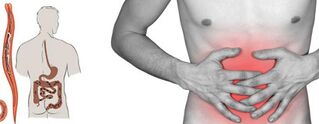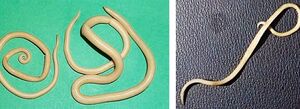
As you know, parasites are considered the most resistant organisms to the external environment. To date, around 250 species are recognized as helminths capable of infecting humans. All of them pose a threat to the health and, in the most serious cases, the lives of those infected. Knowledge about the types of helminths in humans and their characteristics greatly facilitates treatment and helps to develop an effective preventive plan.
What kind of worms do humans have?
It takes a long time to become fully familiar with the types of worms. The fact is that until now, scientists cannot provide the most detailed information on the classification of parasites. This is due to a greater extent to the fact that a certain area is characterized by the presence of specific helminthic invasions. In this sense, it is almost impossible to obtain data on all types of human helminths existing on Earth.
Therefore, worms, most frequently diagnosed in the southern zone, are practically not found in the population of the northern geographic regions. For the temperate climatic zone and mid-latitudes, about 20 varieties of worms are recognized as the most common. They can be conditionally divided into 3 main categories:
- Round parasitic worms (nematodes).
- Helminth tape (cestodes).
- Flatworms (trematodes).
1. Round and flat helminths
Each of the above groups includes a wide variety of parasitic organisms that require a brief description. In children and adults, most often it is necessary to treat representatives of worms that belong to the class of trematodes:
- Chinese chance;
- chance cat;
- liver parasite.
Among nematodes, there are 7 of the most famous and common species of parasites that inhabit the body of any age. Roundworms that are transmitted by all possible means are:
- pinworms;
- roundworm;
- intestinal acne;
- whipworms;
- Trichinella;
- tricostrongylides;
- hookworms.
2. Cestode invasions
Tapeworms (or cestodes) are parasitic worms that pose the greatest threat to the body. Diagnosis of such helminthic infestations occurs much less frequently than roundworm infections in children and adults; however, infection with the following types of worms has the most serious consequences:
- was bullish;
- dwarf tapeworm;
- pork tapeworm;
- wide ribbon;
- echinococcus;
- rat tapeworm.
One of the rarer types of helminthic invasions is the acantocephalus. These include the giant crest and the bead crest. These worms can enter the body in the rarest cases, for example, when they eat an insect or its larvae infected with parasites.
Why are worms dangerous to humans?
To properly assess the degree of threat to the patient's health in case of helminth settlement, it is first necessary to determine to which types of worms they belong. Depending on the type of worms, the treatment and its duration are determined. The main damage from the presence of parasites in the body is felt by the intestines; most helminths are located in this organ. All the nutrients that must be absorbed and benefit a person are selected by worms.
Meanwhile, other types of worms don't just settle in the intestines and "steal" all the valuable microelements needed from humans. They actively multiply and affect other vital human organs and systems. In addition to the heart muscle, liver, and lungs, worms can cause tremendous damage to the brain and blood vessels. Worms can even infect the eyes.
Main forms of infection by worms

You can protect yourself and your loved ones from the onset of illness by knowing how helminths of a particular species enter the body. This is the only way to take all necessary measures in a timely manner and minimize the risk of infection. The main transmission routes are known that:
- Infection occurs through soil and water. When walking on the floor barefoot, the risk of laying eggs indoors increases several times. An unverified water source and in common cases even water from a common water supply can contain maggot larvae.
- Helminth eggs enter the body along with animal products. The result of helminthic invasions is insufficient or poor quality processing of meat, fish, shellfish, and eggs. People who prefer exotic Asian cuisine are at risk for worms. Sushi, sashimi are based on raw meat and fish.
- Some types of parasites can settle in the intestine, having entered it together with unwashed vegetables and fruits. The rejection of animal products does not solve the problem of the probability of developing helminthiasis. Worm eggs, as already mentioned, can be contained in the soil. It is recommended to pour boiling water over the fruits before using them.
- Worms are transmitted to humans and animals. Pets do not usually become a source of infection for their owners. However, worms can be found both inside the animal and on its fur. From cats and dogs, the parasite eggs fall to the ground and spread further with the melted water.
Transmission of parasites from sick people
Worms can also pass from one infected person to another. There are several ways to transmit Helminthic invasions:
- through unwashed hands (eg, shaking hands, hugging);
- when using common utensils;
- when wearing someone else's underwear;
- group application of personal hygiene products by several people.
Pinworm eggs are most frequently passed from person to person, often falling under the nail plates and staying there for a long time. The prevalence of this type of worms in children is explained by the neglect of the elementary rules of cleaning. A child can simply put their hands in their mouth or bite their nails, so pinworms have no difficulty penetrating a new human body. The task of parents at this stage is to timely recognize the signs of helminthiasis and prevent the development of helminthic invasions in their baby, immediately beginning to treat the disease.
Symptoms of the acute stage of helminthiasis
It is not easy to detect the first signs of a parasitic infection in an adult or child. Diagnosing the presence of worms is also complicated by the fact that the incubation period in some species can last up to a year and a half.
As a general rule, the first symptoms of worm infestation appear after several periods. Also, the course of helminthiasis can be conditionally divided into 2 stages:

- acute stage (lasts on average no more than two months after the incubation period);
- chronic (characterized by the development of sexually mature parasites and can last for decades).
In the acute phase of invasion, the main symptom, clearly expressed, may be called an allergic reaction. As a result of the production of antibodies on the migration of the parasitic larvae, the pathological manifestations on the skin should be alerted. An indicator of infection with any type of worm in humans is the following symptoms:
- hyperemia of the skin;
- burning and itching sensation;
- small eruptions on the surface of the epidermis or mucous membranes;
- mild lymph node enlargement;
- local swelling;
- sternum pain (up to choking attacks);
- persistent vomiting and nausea;
- diarrhea or constipation.
In addition, such dangerous pathologies as pneumonia, meningoencephalitis, hepatitis can become complications of the appearance of other creatures in the body.
A reliable confirmation of the presence of helminths in internal organs is the eosinophil index in the clinical blood test. The increase in the value of these particles is due to dysproteinemia, a violation of the normal numerical ratio between protein fractions.
Types of symptoms in the chronic form of the disease
Signs of chronic helminthiasis in humans are determined by the location of parasite colonization. In simple terms: the manifestations of the disease will depend on which organ will become the main habitat of a particular type of worm.
In particular, the most common parasitism in the intestines of pinworms can continue even without the slightest symptom. If the larger species are affected by the worms, the signs of the disease will be noticeable as soon as the worms reach puberty. Dyspeptic disorders in an adult and a child, pain syndrome and neurotic manifestations are its characteristic features. Ascariasis is often characterized by the development of intestinal obstruction and pancreatitis, and increases the risk of cancer diseases.
Anti-parasite drugs
It is necessary to undergo helminthiasis treatment at the earliest possible stage. An effective therapy will be if, before starting it, it is known exactly what type of parasite has settled in the body. Today, there are many anthelmintic medications.
These are different types of drugs that can attack a specific type of worm. The strongest antiparasitic medications are broad-spectrum medications and are excellent for treating combined helminthiasis. Both are considered toxic, they have many side effects and contraindications. The use of such drugs should be carried out with extreme caution only after a medical recommendation.
Most types of worms in an adult take a long time and persistently. Often, parasitologists prescribe the simultaneous administration of several anthelmintic drugs.
The regimen and dose of a specific drug should be exclusively prepared by a specialist. This will help avoid allergies and serious side effects. For some types of helminth infection, treatment must be repeated. This is often due to the fact that during the first therapy most of the adult worms were neutralized, but some forms of larvae and worm eggs still remain in the patient's body. If not treated again, the worms will reappear.
Basic prevention measures
Pharmacotherapy is undoubtedly an important part of the process of elimination and, in some cases, prevention of parasites. However, to deal with invading worms, you need to follow the simplest rules to prevent worms. The treatment will not work if you ignore the following rules:
- Wash your hands often, especially after using the bathroom and before eating.
- If it is not possible to clean the skin of the hands with soap, it is recommended to use antibacterial wipes.
- All food must be rinsed well before cooking.
- It is important to expose meat and fish to prolonged exposure to heat.
- Use only water from reliable sources for drinking.
- At least once a year, it is extremely important to get tested for worms.


















































